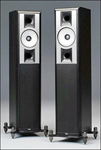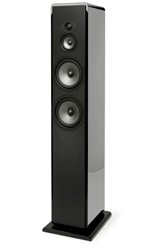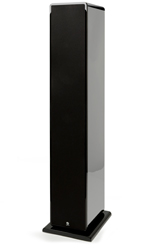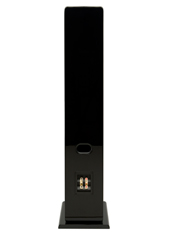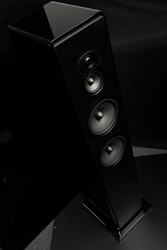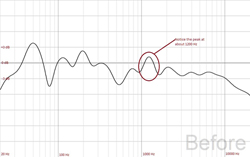Introduction
The Boston Acoustics RS 326 represents the top model in Boston Acoustics’ Reflection series, which includes numerous floor-standing, bookshelf, and center channel speakers along with a matching subwoofer. Second only to the VS line, the Reflection series was designed to create an “elegant fusion of technology, performance, and stylish good looks (to quote the Boston Acoustics website).” In this 2-channel review, we’ll see how well the RS 326s live up to those lofty design goals.
Specifications
- Design: 3-way, Ported Enclosure
- Drivers: One 1″ Dome Tweeter, One 3.5″ Fiber Ceramic Midrange, Two 6.5″ Woofers
- MFR: 38 Hz – 26 kHz
- Nominal Impedance: 8 Ohms
- Sensitivity: 89 dB SPL/2.8 V/m
- Dimensions: 44.1″ H x 10.5″ W x 12.3″ D
- Weight: 47 Pounds/each
- MSRP: $999.99/each
- Boston Acoustics
Design
The RS 326 is a very sleek-looking tower. The speaker is rather tall at 44 1/16 inches but merely 7 13/16 inches wide, making the speaker appear very trim when viewed from the front. Boston Acoustics has attached a plinth to the base to increase stability, which raises overall width to a still svelte 10 ½ inches. The plinth comes with rubber-coated screw-in feet pre-attached from the factory, but these are easily replaced with the included carpet spikes if needed. Even with the 12 5/16 inch depth, it should still be relatively easy to place this speaker in most rooms of medium to large size and may even work in smaller rooms. The cabinet is constructed of 3/4 inch MDF, with internal bracing to increase overall rigidity. Knocking my knuckles against various points of the cabinets resulted in a pretty deadened thunk, though certain parts of the cabinet seemed to reverberate a bit more than others. The front baffle is a unique design called “Super Linear Plane” (SLP) which is designed to reduce acoustic diffraction. Moving around to the back of the speaker one finds an oval-shaped port and two sets of five-way binding posts which allow for bi-amping or bi-wiring if desired.
The smooth look of the SLP baffle is further enhanced by the use of invisible mounting hardware for all of the drivers. Per Boston Acoustics’ technical director, the drivers are mounted to the front baffle using standard hardware and then a “trim ring” is applied over the attachment point. These trim rings use pins to push into mounting holes, similar to the design of many speaker grilles. The speaker grilles are constructed of a plastic frame with cloth stretched across. Magnetic attachment points make the grilles an absolute breeze to remove. Finishing the whole cabinet off is a very nice high-gloss black lacquer finish. Boston Acoustics has developed a polyester-based lacquer that is designed to offer increased scratch resistance, though I didn’t have the heart to run a key across the beautiful finish to test out this claim. The lacquer itself is applied in a multi-step process consisting of spraying, sanding, and then buffing. This three-step processed is performed multiple times, with each consecutive application yielding a finer appearance, with the finished product displaying great dept of gloss.
Overall, the RS 326 presents itself very well, and should earn solid marks from your interior designer (or spouse) with its clean, modern look. However, I do feel compelled to mention that gloss black may not be the best choice for those of you with darkened theater room setups as the high gloss finish could create a lot of reflection from your video display.
Moving on to the drivers, the RS 326 sports a true 3-way design. The 1-inch Extended Wide Bandwidth (EWB) tweeter looks like a standard silk/fabric dome tweeter until you get to the center, where there is a little dimple. This dimple is also known as central diaphragm termination and was designed to stabilize linear motion and lower distortion while improving dispersion, power handling, and clarity. The EWB tweeter operates up 26kHz and is crossed-over to the midrange driver at 3700Hz. The 3 ½ inch Fiber Ceramic Copolymer Material (FCCM) midrange reaches down to about 600Hz, where it is crossed-over to the dual 6 ½ inch FCCM woofers. These woofers use Boston Acoustics’ Deep Channel® Design, which allows for increased excursion without sacrificing the strength of the magnetic field.
Setup
One of my speakers was damaged in shipping and arrived with its base plinth cracked. Each box has a piece of plywood strengthening the bottom of the box beneath the plinth, so the speaker must have been dropped pretty heavily in order to do this kind of damage. While I can’t blame Boston Acoustics for the rough treatment during shipping, I would suggest that the speakers be shipped without the plinth attached. Four screws are used to attach the plinth to the speaker, so this is something that the purchaser could easily do themselves and it might help eliminate damage like I experienced. I was quickly sent out a replacement speaker which arrived intact.
Unboxing the speakers proved to be a little more eventful than usual. The RS 326s are shipped with a white cloth bag covering them. The cloth bag makes things extremely slippery and it is easy to drop the speaker. I highly recommend that you try to slide the bag off the speaker before attempting to pull it out of the box. While the cloth bag looks cool, something like thin foam would make for a more “secure” removal process. Beneath the cloth bag, a second layer of thick plastic wrap further protects the gloss surface of each speaker. This wrap peels off easily and seems to protect the gloss finish well. I did not notice a single scratch or blemish in the finish of either speaker. I recommend keeping the plastic wrap on until you have the speaker in its final position as it gives your hands a nice bit of extra grip on the speaker. Once you remove the plastic, you may want to use the supplied white cotton gloves to keep from glomming up the finish with your fingerprints. The RS 326s ship with rubber feet pre-installed, but since I was putting the speakers on carpet I decided to install the included carpet spikes instead. The rubber feet are easily unscrewed using a Hex-head (Allen key) driver, but oddly one is not included in the box. The carpet spikes can then be threaded in by hand and tightened with a wrench if desired.
I set up the RS 326s in my basement media room, connecting them to my Wyred 4 Sound multichannel amp (570 Watts@8 Ohm for the front speakers) via Kimber 4VS speaker cable in a bi-wired setup. The amp was connected via XLR connections to my Integra DHC-9.9 pre-amp and fed primarily by a NuForce Edition Oppo BDP-83SE universal player via either HDMI or 2-channel analog output. I started with the speakers about 8 feet apart from each other, with their rear baffles about 3 feet from the back wall and 4 feet to each side wall. As the instructions provided with the RS 326s provide no guidance at all in regards to speaker setup, I started with the speakers toed-in directly to my listening position. While on the topic of instructions, I was very disappointed in the brevity of the single page worth of information included with the speaker. There was no information on how to swap out the different types of speaker feet nor was there any information on speaker placement/setup. There was also no mention of how to set up the speaker in a bi-wired or bi-amped setup. Many novices may not know that you must remove the jumpers between the two pairs of binding posts before bi-amping or bi-wiring. While I understand that most people purchasing a $1999.98 pair of speakers will already have this knowledge, there are those who won’t and it is easily rectified by improving the instructions.
In Use
Boston Acoustics does not have a stated break-in time for the RS 326s, but I gave them 50 hours of playback before doing any serious listening. To my ears, the RS 326s loosened up noticeably after the 50-hour mark, reaching their peak performance after about 100 hours. I also made a few adjustments to the speaker position during the break-in time. First, I moved the speakers a little closer to my rear walls, finishing up with 2 feet between the back baffle and wall. This gave the rear port enough room to breathe without creating boomy bass. I kept the distance from the side walls at 4 feet, which seemed to offer the best combination of imaging and soundstaging. I was not happy with the midrange during my first listening sessions, so I experimented with toe-in and found that I preferred the RS 326s with almost no toe-in at all. This smoothed out the midrange response a bit and also improved imaging. Finally, I experimented with the speaker grilles. While there was just a tad more treble detail with the grilles off, the midrange sounded better with the grilles on. My preference did not surprise me, as the RS 326s were voiced with their grilles on as this is how Boston Acoustics anticipates most owners will use them.

With the RS 326s situated, it was time for some serious listening. I started off with my go-to evaluation disc, Reference Recordings fantastic sounding Symphonic Dances (RR-96CD) on HDCD. This is a very dynamic disc recorded with a full symphony and requires a big sounding speaker to get it right. The RS 326s got it mostly right. Bass was incredibly punchy, with much more accuracy and depth than I expected given the modest 6-1/2 inch woofers. Treble was smooth, extended, and detailed but did not possess the air and life that I’ve heard from other speakers in my room. Dynamics were good, with the speaker coming alive on the more thunderous crescendos. Imaging and soundstaging were fair, but I have heard better. However, there were some definite issues with the midrange. Leading edges of brass and woodwind instruments had an exaggerated “bite” to them that I did not care for. While my ears are extremely sensitive in the midrange (particularly from 800 Hz to 5 kHz) and will pick up any trace of excess energy, there was a noticeable amount of extra zip through the RS 326s.



Having played classical and electric guitar my whole life, I decided to switch over to some guitar driven tracks to more adequately assess the midrange. I popped in Azucar (Avalon – B00000J6Z0) and queued up track 4, “Dusk.” I was immediately impressed with the quality and power of the bass kicks that start off this track, which made the RS 326 sound like a far more expensive speaker. However, as soon as the Spanish guitar started being plucked, I knew that something was amiss. The guitars used on this track are of the Spanish variety, which use nylon strings to impart a softer, warmer tone. What I was hearing was clearly brighter and more aggressive, as ifthe nylon strings were swapped out for steel ones. There was an initial harshness to each guitar note that should not have been there and I noticed a loss of the “woody” tone created by the guitar body.
To hear how electric guitar would sound through the RS 326s, I switched over to Stevie Ray Vaughn’s “Little Wing” from The Sky Is Crying (Sony B0000027KO). Unfortunately, the same excessive energy on the attack of midrange notes was still present, though even more emphasized due to the wailing nature of Vaughn’s Stratocaster. Higher notes sounded more natural, though they were still lacking a bit of air and sustain.
I wanted to hear some vocal tracks before passing final judgment on the midrange so I put Norah Jones Come Away With Me SACD (Blue Note – B00008WT49) into the Oppo, set the player to output 2-channel SACD, and keyed up track 7, “I’ve Got to See You Again.” Even with a smoother sounding SACD in the mix, the initial edge of each vocal possessed a sharpness that detracted from the velvety-smooth character of Jones’ beautiful voice. Listening to the whole track, I also noticed that theimaging and soundstaging of the RS 326s was merely average. Norah’s voice wasn’t as solidly centered in space as I’ve heard from other speakers, nor did the soundstage give a great sense of depth or width. I didn’t get that “you are there” feeling like I do with my current speakers or the Dynaudio X16s I reviewed a little over a year ago.
At this point in time I decided to give the RS 326s a full blown Audyssey Pro calibration through my Integra DHC-9.9 pre-amp to see if I could improve the overall sound. Prior to calibration (see the frequency response plotabove), you can see that there was a noticeable spike in output around the 1200Hz region of roughly 2-3dB compared to the frequencies above and below. This would certainly account for the extra “bite” I was hearing with certain brass, guitar, and vocal notes. There was also a noticeable drop in output around 550Hz, which could account for some of the missing life and body I was experiencing. Keep in mind that this frequency response graph was generated at the primary seating position in my room, so these graphs should not be compared to anechoic measurements. However, shy of a bass mode around 80Hz, my room doesn’t have any particular anomalies, so I’m pretty confident that the excess presence region energy was generated by the speakers. Moving the speakers around to different locations didn’t noticeably improve these peaks and troughs either. I typically remove the midrange dip that Audyssey Pro inserts by default, but with the RS 326s it could help tame the harsher tone through the presence region so feel free to experiment. I ran through the prior demo tracks with Audyssey engaged and noticed a definite improvement in the smoothness of the sound (see the post-Audyssey calibration frequency response plot above), albeit at a slight decrease in clarity and life. While I personally love what Audyssey room correction does for multi-channel and home theater sound, I still prefer my 2-channel listening to be done with no correction. With the RS 326s, the smoother sound far outweighed the slight loss of realism, so I left it on for the rest of my listening.


Since the RS 326 is a physically large speaker, I figured I’d give it a workout with some higher volume stuff. Metallica’s “And Justice For All” (Elektra B000002H6C) has a host of monster tracks, my favorite being the almostentirely instrumental “To Live Is To Die.” While this recording is a bit on the harsh side, it is great fun nonetheless. I slowly cranked the volume level while watching my SPL meter. My ears gave up at about 100 dB, but the RS 326s could have kept on going. I couldn’t detect any increased harshness at these high levels, and bass was absolutely punishing (in a good way). Given the relatively small drivers, I was very surprised to see the RS 326s hit this kind of output. To confirm that it wasn’t a fluke, I queued up DJ Tiesto’s signature “Adagio for Strings” (Nettwerk B00097DX6W) and cranked the volume again. 100 dB of output was easily reached, and I was amazed at how strong and powerful the filtered bass kicks were. I didn’t sense any strain at all from the speaker at these incredibly loud levels, so if you are someone who really likes crank up their music, the RS 326s could be a good option. However, if the recording is brighter in nature, as most modern recordings are, the RS 326s could become a bit fatiguing.
Conclusions
The RS 326 does a lot of things right. Bass is incredibly clean, deep, and punchy and treble is smooth and detailed. The speaker looks great, and will blend into your home décor about as well as any 44″ tall tower speaker could. Output levels are prodigious, which could be great in a home theater setup or if you listen to your music at high SPL levels. However, the life blood of music is in the midrange, and this is where the RS 326 falters a bit with its rather aggressive nature. $999.99 per speaker is a sizeable budget, and the RS 326 faces a lot of stiff competition in this price range. As always, I recommend getting a good demo session to see if the RS 326 suits your tastes.


